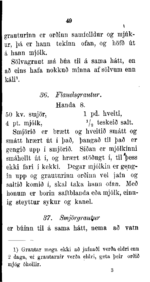Signature mark
A signature mark, in traditional bookbinding, is a letter, number or combination of either or both, which is printed at the bottom of the first page, or leaf, of a section. (The section is itself often known as a "signature", although technically this usage is incorrect.) The aim is to ensure that the binder can order the pages and sections in the correct order. Often the letters of the Latin alphabet have been used. The practice has been overtaken by advances in printing technology, and signature marks are rarely found in modern books.[1]

Contemporary use of signature marks
A number of symbols traditionally used as binding signature marks were encoded in ISO 5426-2[2] and from there (to enable migration of data from the old standard) found their way into Unicode.
- 0x32 REFERENCE MARK was unified with U+203B (※)
- 0x34 MALTESE CROSS, with U+2720 (✠)
- 0x36 RIGHTWARDS LEAF ARROW, with U+2767 (❧) ROTATED FLORAL HEART BULLET (also known as "hedera" and "ivy leaf")
- 0x37 LATIN CAPITAL LETTER SIDEWAYS Q had to be added into Unicode as U+213A (℺), ROTATED CAPITAL Q[3]
U+2619 (☙), REVERSED ROTATED FLORAL HEART BULLET, was added later. These latter two are the only codepoints in Unicode 4.0 to bear the annotation "binding signature mark".
References
- Matt T. Roberts and Don Etherington, Bookbinding and the Conservation of books: A Dictionary of Descriptive Terminology - signature mark
- 1996, Information and documentation -- Extension of the Latin alphabet coded character set for bibliographic information interchange -- Part 2: Latin characters used in minor European languages and obsolete typography
- Michael S. Kaplan (10 January 2005). "Every character has a story #1: U+213a (ROTATED CAPITAL Q)". Sorting it all Out, v2. Archived from the original on 9 September 2006. Retrieved 21 October 2015.